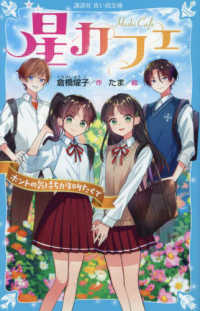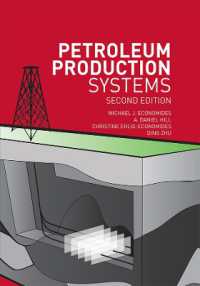Full Description
This volume brings together leading scholars from Africa, Europe, the Americas and beyond to provide a detailed account of the languages of the Bantu family, which cover an area from Cameroon and Kenya in the north to South Africa in the south. The Bantu family is part of the Niger-Congo phylum and one of the world's biggest language groups, comprising around 500 languages. The family includes major languages with large numbers of speakers, such as Zulu, Kinyarwanda, and Swahili, the most widely spoken and taught African language, as well as many community languages and several endangered languages. Bantu languages feature prominently in the complex and multilingual language ecologies that are characteristic of the linguistic situation in much of Africa and they provide rich evidence for the study of theoretical and comparative linguistics, language contact, and language change. They play an important role in education, commerce, culture, and artistic expression, in the media and public discourse, in governance and social justice, and are central to the future of the continent and the well-being of its communities.
The first part of The Oxford Guide to the Bantu Languages provides background and context, with chapters exploring the history of research in the field; language and prehistory in Bantu-speaking Africa; and typology and variation. Chapters in the second part offer broad comparative overviews of Bantu phonology, morphology, syntax, semantics and pragmatics, socio- and applied linguistics, before Parts III - VII cover more specific topics in Bantu linguistics across a variety of subfields, ranging from structural issues such as the augment and melodic tone to historical and sociolinguistic topics such as Bantu languages in the diaspora and language policy and standardization. The chapters in the final part offer individual structural overviews of a range of languages from across the Bantu-speaking area. The book will be an essential resource for students and researchers specializing in the Bantu languages and for typologists and comparative linguists more broadly.
Contents
1: Lutz Marten, Ellen Hurst-Harosh, Nancy C. Kula, and Jochen Zeller: Introduction
Part I. Historical and typological background
2: Andrew van der Spuy: A history of research into Bantu linguistics
3: Koen Bostoen: Language and (pre)history in Bantu-speaking Africa
4: Denis Creissels: Typology and variation
Part II. Comparative overviews
5: Al Mtenje: Phonology
6: Larry M. Hyman: Tone
7: Lutz Marten: Morphology
8: Michael Diercks and Vicki Carstens: Syntax
9: Axel Fanego Palat: Semantics and pragmatics
10: Felix Banda: Sociolinguistics and applied linguistics
Part III. Topics in Bantu morphology and syntax
11: Josephat Rugemalira: Noun classes and agreement
12: Lisa Lai-Shen Cheng: Relative clauses
13: Mark L. O. Van de Velde: Attributive possession
14: Claire Halpert: The augment
15: Justine Mukhwana Sikuku: Subject and object marking
16: Kristina Riedel: Object (a)symmetries
17: Deo S. Ngonyani: Applicative constructions
18: Silvester Ron Simango: Causative constructions
19: Rozenn Guérois: Passive constructions
20: Fatima Hamlaoui: Inversion constructions
21: Jenneke van der Wal: The conjoint/disjoint alternation
22: Robert Botne: Tense and aspect
23: Maud Devos: Negation
24: Hannah Gibson: Auxiliary constructions
25: Jochen Zeller: Locatives
26: Patricia Schneider-Zioga: Non-verbal predication
27: Rose Letsholo-Tafila: Clause linkage
Part IV. Topics in Bantu semantics and pragmatics
28: Thera Marie Crane: Lexical structures and lexical semantics
29: Maarten Mous: The lexicon of the mixed language Ma'á/Mbugu
30: Steve Nicolle: Narrative discourse
31: Yukiko Morimoto and Nobuko Yoneda: Topic and focus
Part V. Topics in Bantu historical and comparative linguistics
32: Jeff Good: Historical morphosyntax and syntactic change
33: Eva-Marie Bloom Strom and Malin Petzell: . Micro-variation approaches to Bantu language varieties
34: Rasmus Bernander: Language contact and convergence
35: Rebecca Grollemund and Mark Pagel: Phylogenetic approaches to Bantu historical linguistics
36: Margarida Petter, Esmeralda Vailati Negrão, and Evani Viotti: Bantu languages in the diaspora
37: Nancy C. Kula: Vowel harmony
38: Maxwell Kadenge: Hiatus resolution
39: William G. Bennett: Consonantal processes
40: Michelle Morrison: Imbrication
41: Jonathan Nyabuto Choti: Nasal prefix segmental processes
42: Lee Bickmore: Melodic tone
43: Lotta Aunio: Nominal tone
44: Seunghun J. Lee: Depressor consonants
45: Njoya Ibirahim: Reduplication
46: Didier Démolin and Cédric Patin: Phonetics
47: Laura J. Downing: Prosody-syntax interface
48: Annie Rialland: Intonation
Part VII. Topics in Bantu sociolinguistics and applied linguistics
49: Stephanie Rudwick and Rose Marie Beck: Multilingualism in Bantu languages
50: Herman M. Batibo: Language endangerment and vitality
51: Rajend Mesthrie: Fanakalo, a Bantu-lexified pidgin
52: Ellen Hurst-Harosh: Youth language and registers
53: Judith Nakayiza and Medadi E. Ssentanda: Language policy and standardization
54: Ashraf Abdelhay, Cristine Severo, and Sinfree Makoni: Towards a decolonial Bantu linguistics
55: Ramona Kunene Nicolas: Language acquisition in Bantu languages
56: Naledi N. Kgolo-Lotshwao: Mental representation and processing
57: Russell H. Kaschula, Michael M. Kretzer, and Peter N. Mose: African languages in education in Sub-Saharan Africa
58: Fridah Erastus Kanana: Bantu languages in the media
59: Alena Rettová: Literatures in Bantu languages
Part VIII. Language descriptions
60: Roland Kießling: West Ring (Grassfields Bantu)
61: Gratien G. Atindogbé: Barombi (A41)
62: Emmanuel-Moselly Makasso: Basaa (A43)
63: Joseph Koni Muluwa: Nsamban (B85F)
64: Nico Nassenstein: Bangala (C30A)
65: Michael Meeuwis: Lingala (C30B)
66: Jean Paul Ngoboka and Cyprien Niyomugabo: Kinyarwanda (JD61)
67: Fridah Katushemererwe: Runyakitara (JE10A)
68: Saudah Namyalo and Jackson Ssekiryango: Luganda (JE15)
69: Christopher R. Green, Michael R. Marlo, and Michael Diercks: Wanga (JE32A)
70: Daisuke Shinagawa: Rwa (E621A), Uru (E622D), and Mkuu (E623C): Less described varieties of Kilimanjaro Bantu (Chaga) languages
71: Amani Lusekelo: Kiswahili (G40)
72: Brent Henderson: Chimiini (G412)
73: Karsten Legère: Kwangali (K33)
74: Stephen T. M. Lukusa: Cilubà (L31)
75: Boniface Kawasha: Lunda (L52)
76: Kelvin Mambwe: Bemba (M42)
77: Nobuko Yoneda: Matengo (N13)
78: Pascal J. Kishindo: Chinyanja/Chichewa (N31)
79: Armindo Ngunda and Carlos J. Manuel: Emakhuwa (P31)
80: Jekura U. Kavari: Otjiherero (R30)
81: Nhlanhla Mathonsi: Zulu (S42)
References







